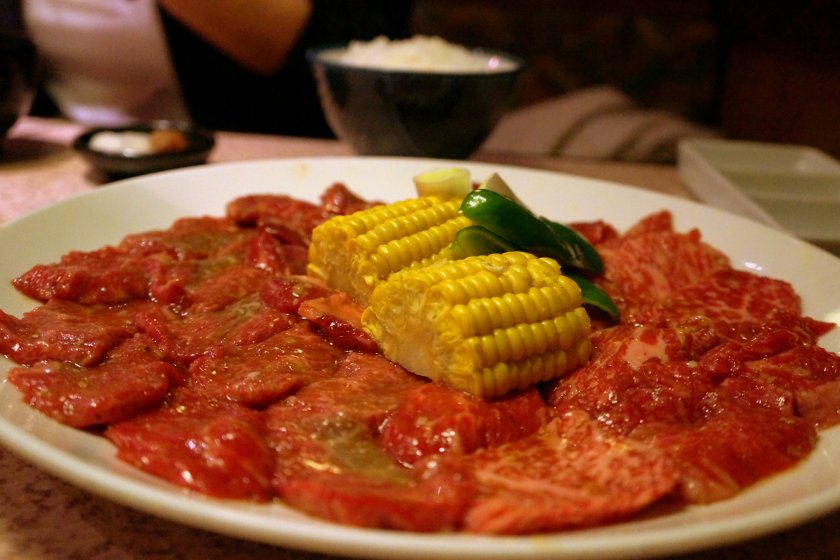If you're a traveler coming to Japan I'm sure eating some great Japanese food is high on everyone's agenda. By the very virtue of you traveling to Japan it says that you are somewhat adventurous. So you'll be walking around different cities and popping your head into many restaurants. At least you should be in my opinion. There is no reason to play it safe and find the nearest McDonalds. You will undoubtedly find restaurants where the menu is in Kanji or Japanese only and the owners will not speak your language. I admit that would be a difficult but not insurmountable problem. You could turn around and walk out or you could see what everyone else is eating and point to their dishes. Or maybe the menu has pictures. Or you could point to the plastic food plates outside the restaurant for your order. Some of the best meals and adventures are found by just walking in and see what happens. Sometimes you strike out, but more often than not, you'll end up having a great experience.
Most people coming to Japan make an effort to learn some Japanese basics. The study list incudes a little bit of the spoken and written language and perhaps some Japanese customs. A huge task that most don't deal with though is learning those Chinese looking characters called Kanji. With the right approach you can learn many kanji in a reasonable amount of time. But for most, you just want to get by, and perhaps learn some of the most common or most important kanji that you might encounter.
From a food perspective, I may be able to shed some light on the kanji problem. You want to know if the menu says raw or cooked. You'd like to know if you're ordering chicken, beef, pork, eggs, or vegetables. You'd like to know if it's a soup, salad, and if it is baked or boiled. Most menus will have this information so it's up to you to figure it out or bring a good interpreter along.
I have developed a list of what I call Key Food Kanji. Today's installment is all about meat.
For this first series, we will start with beef, pork, and chicken related dishes. Most restaurants will serve something in this category. Unless you have somehow stumbled into a tofu restaurant.
肉 "niku" meat (beef, pork, chicken)
牛 "gyu" beef
豚 "buta"pork
牛肉 "gyuniku" [ぎゅうにく] beef
牛丼 "gyudon" [ぎゅうどん] rice covered with beef and vegetables
和牛 [わぎゅう] Wagyu beef, Japanese beef
近江牛 [おうみぎゅう, おうみうし] Omi beef
米沢牛 [よねざわぎゅう] Yonezawa beef
松阪牛 [まつさかうし] Matsusaka beef
神戸肉 [こうべにく] Kobe beef
カルビ "kalbi" Korean-style beef ribs
すき焼き, すき焼, [すきやき, スキヤキ] sukiyaki, thin slices of beef, cooked with various vegetables in a table-top cast-iron pan
タンtongue of beef, pork, etc.
豚肉 "butaniku" [ぶたにく, とんにく] pork
豚めし, 豚飯 "butameshi" [ぶためし] pork with rice
豚丼 "butadon" [ぶたどん, とんどん] rice covered with pork and vegetables
豚カツ "tonkatsu" [とんカツ] pork cutlet
黒豚 "kurobuta" [くろぶた] Berkshire pig
鶏 "tori" [にわとり, とり] (domestic) chicken, chicken (meat)
焼き鳥, 焼鳥 [やきとり] yakitori, chicken pieces (or sometimes beef or pork offal) grilled on a skewer
若鳥, 若鶏 "wakadori" [わかどり] chick, chicken
チキン, チッキンchicken
笹身 "sasami" [ささみ] high-quality chicken breast meat
手羽先 "tebasaki" [てばさき] (tip section of) chicken wing, second segment of chicken wing
鴨, 鳧 "kamo" [,カモ] duck, easy mark, sucker, sitting duck
餃子 "gyoza" [ギョーザ, ギョウザ, チャオズ] pot sticker, gyoza, crescent-shaped pan-fried dumplings stuffed with minced pork and vegetables
So you can see the patterns. Beef, pork, and chicken. You probably also recognized Kobe beef and saw a few other types listed. In Japan Kobe is just one choice of many possible quality beef choice. Some argue that Matsusaka beef is actually better. Others say the Omi is king. If you're in a major city you can find restaurants that serve it and you can find it in some of the larger food basements or "depachika." But that may be another post in itself.
In the next installment we'll cover menu basics like raw, baked, deep fried, vegetables, etc. and some key restaurant phrases.






























